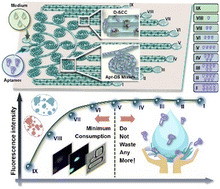Intolerance of profligacy: an aptamer concentration gradient-tailored unicellular array for high-throughput biologics-mediated phenotyping†
Abstract
In aptamer-based assay schemes, aptamer probes not labeled with biomarkers have to be eliminated before testing, which may lead to a tremendous waste of precious probes. We herein propose a microfluidics system integrating an aptamer concentration gradient generator (Apt-CGG) and a dual single-cell culturing array (D-SCA), termed Mi-Apt-SCA. This facilitates the precise construction of a nanoscale-gradient microenvironment and the high-throughput profiling of single-cell growth/phenotypes in situ with the minimal consumption of Apt-probe. Unlike previous snakelike mixers, the choreographed winding-ravined aptamer dual-spiral micromixer (Apt-WD-mixer) in Apt-CGG could allow thorough blending to generate linear concentration gradients of aptamer (quasi-non-Newtonian fluid) under the action of continuous fluidic wiggles and bidirectional Dean flow. In contrast to other trap-like systems, the mild vortex allows single-cell growth in an ultra-tender fluidic microenvironment using triple-jarless single-cell culture capsules (TriJ-SCCs) in D-SCA (shear stress: 3.43 × 10−5 dynes per cm2). The minimum dosage of aptamer probe required for exploring PDL1 protein expression in two hepatoma cell lines is only one-900th of that required by conventional protocols. In addition, this approach facilitated the profiling of ITF-β/cisplatin-mediated single-cell/cell-cluster phenotypes.



 Please wait while we load your content...
Please wait while we load your content...